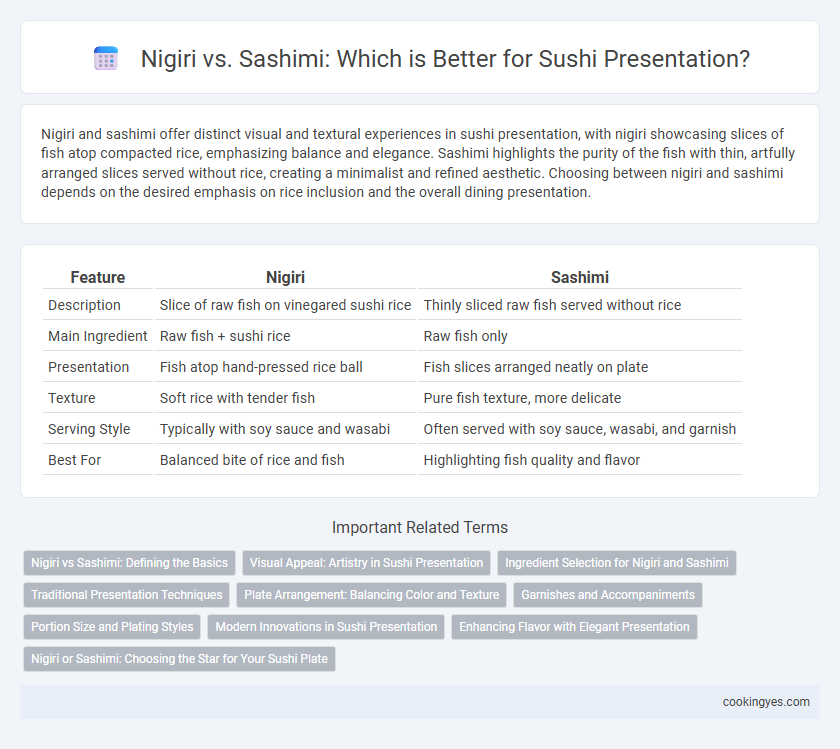Nigiri and sashimi offer distinct visual and textural experiences in sushi presentation, with nigiri showcasing slices of fish atop compacted rice, emphasizing balance and elegance. Sashimi highlights the purity of the fish with thin, artfully arranged slices served without rice, creating a minimalist and refined aesthetic. Choosing between nigiri and sashimi depends on the desired emphasis on rice inclusion and the overall dining presentation.
Table of Comparison
| Feature | Nigiri | Sashimi |
|---|---|---|
| Description | Slice of raw fish on vinegared sushi rice | Thinly sliced raw fish served without rice |
| Main Ingredient | Raw fish + sushi rice | Raw fish only |
| Presentation | Fish atop hand-pressed rice ball | Fish slices arranged neatly on plate |
| Texture | Soft rice with tender fish | Pure fish texture, more delicate |
| Serving Style | Typically with soy sauce and wasabi | Often served with soy sauce, wasabi, and garnish |
| Best For | Balanced bite of rice and fish | Highlighting fish quality and flavor |
Nigiri vs Sashimi: Defining the Basics
Nigiri consists of hand-pressed vinegared rice topped with a slice of fresh fish or seafood, blending texture and flavor in each bite. Sashimi features thinly sliced raw fish or seafood served without rice, emphasizing purity and the natural taste of the ingredients. Understanding the distinction between Nigiri and Sashimi is essential for mastering sushi presentation and appreciating traditional Japanese cuisine.
Visual Appeal: Artistry in Sushi Presentation
Nigiri showcases a harmonious blend of vinegared rice and expertly sliced fish, creating a balanced, bite-sized masterpiece with contrasting textures and colors that enhance visual appeal. Sashimi, consisting of delicately cut raw fish without rice, emphasizes the purity and natural beauty of each slice, often arranged in artistic patterns that highlight freshness and precision. Both styles demand meticulous knife skills and plating techniques, making them central to the artistry and cultural sophistication of sushi presentation.
Ingredient Selection for Nigiri and Sashimi
Nigiri and sashimi showcase distinct ingredient selections that define their sushi presentation; nigiri requires fresh, hand-pressed sushi rice as its base topped with carefully sliced fish or seafood to balance texture and flavor. Sashimi relies exclusively on the finest cuts of raw fish or seafood, with an emphasis on thickness and freshness, served without rice to highlight purity. Selecting premium-grade fish and considering moisture content and fat distribution ensures optimal taste and presentation for both nigiri and sashimi.
Traditional Presentation Techniques
Nigiri sushi features thin slices of fish carefully molded atop compact, hand-formed rice, emphasizing balance and texture in traditional presentation techniques. Sashimi, served without rice, showcases pristine cuts of raw fish laid out to highlight freshness and knife skills, often garnished with minimal embellishments such as shiso leaves or daikon radish. Precision in slicing and the harmonious arrangement are key elements distinguishing these sushi styles in classic Japanese cuisine.
Plate Arrangement: Balancing Color and Texture
Nigiri combines vinegared rice with a topping of fresh fish or seafood, offering a contrast of soft rice and tender protein that creates visual and textural balance on the plate. Sashimi, consisting of thinly sliced raw fish without rice, emphasizes purity and simplicity, often arranged in overlapping layers to showcase the fish's natural marbling and vibrant hues. Effective sushi presentation balances the bright colors of garnishes like wasabi and pickled ginger with the textures of both nigiri and sashimi, enhancing the overall aesthetic appeal and dining experience.
Garnishes and Accompaniments
Nigiri features thin slices of fish atop rice, often garnished with a dab of wasabi, thinly sliced scallions, or a brush of soy sauce to enhance flavor and presentation. Sashimi is served without rice, accompanied by fresh garnishes like shredded daikon radish, shiso leaves, and a side of pickled ginger to cleanse the palate. Both styles typically include wasabi and soy sauce, but nigiri's rice base allows for a more integrated flavor experience compared to sashimi's pure fish focus.
Portion Size and Plating Styles
Nigiri features a small, compact portion of fish atop a wedge of vinegared rice, offering a balanced bite and structured presentation ideal for individual servings. Sashimi, consisting of thinly sliced raw fish without rice, emphasizes delicate, artful plating that highlights the fish's texture and color, often arranged in minimalist or fan patterns to enhance visual appeal. The portion size of nigiri is typically larger and more filling, while sashimi focuses on pure fish flavor with lighter, smaller servings that emphasize freshness and refinement.
Modern Innovations in Sushi Presentation
Modern innovations in sushi presentation emphasize the distinct appeal of nigiri and sashimi, enhancing visual artistry and flavor combinations. Nigiri showcases hand-pressed vinegared rice topped with fresh fish or seafood, often garnished with edible flowers or microgreens to elevate its aesthetic and taste profile. Sashimi highlights the purity of raw fish slices, now creatively arranged with molecular gastronomy techniques like flavored gels or smoked salts to intensify sensory experience.
Enhancing Flavor with Elegant Presentation
Nigiri showcases a delicate balance of vinegared rice and fresh fish, enhancing flavor through texture contrast and subtle seasoning. Sashimi emphasizes purity, presenting thin slices of premium fish that highlight natural taste and freshness without rice. Both styles offer elegant visual appeal, with nigiri's layered composition and sashimi's artful slicing elevating the overall sushi presentation experience.
Nigiri or Sashimi: Choosing the Star for Your Sushi Plate
Nigiri features hand-pressed vinegared rice topped with fresh fish, offering a balanced blend of texture and flavor that highlights both the rice and seafood. Sashimi solely showcases thinly sliced raw fish, emphasizing the purity and freshness of the seafood without the distraction of rice. Choosing nigiri elevates sushi presentation by combining visual appeal and texture, while sashimi delivers a minimalist, elegant display focused entirely on premium fish quality.
Nigiri vs Sashimi for Sushi Presentation Infographic

 cookingyes.com
cookingyes.com